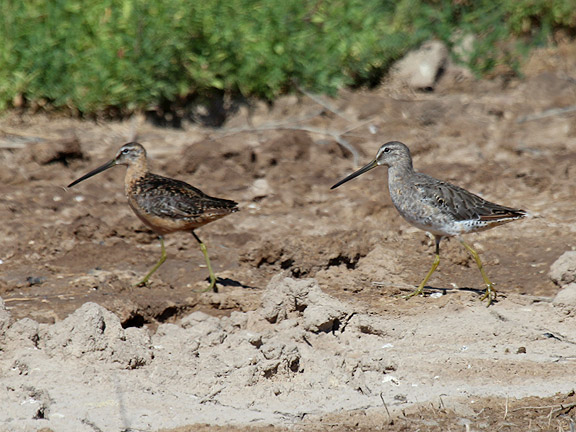
One bird had already molted almost completely into basic plumage, and the other was at the beginning, with a gray hood and mostly rufous body. Neither had obvious barring on the sides, or spotting on the necks The bird that had already molted did appear lighly barred on the side but what would seem in range for a LBDO. The coverts appeared to have nice wide edges clear on quiet a few feathers--not sure whether that is god for one or the other. As for shape the birds looke fairly falt backed when hunched over, but maybe not out of range for a LBDO? Here are some photos (about 5 mixed in with other stuff near the top):
when the birds flew they each gave a 3 note tu-tutulu call which when I heard it in the field sounded like a SBDO. After getting home and hearing it again, I think it may just be a really fast wik wikiki call for a LBDO. It doesn't sound as crisp as a SBDO, and more drawn out like a LBDO. In any event, I listened to it over an over and I am fairly confident it isn't a SBDO, to go along with the visual marks, but wanted some second thoughts. Usually when I see dowitchers, there are so many that the sound is a garbled mess so making out distinct call notes is kind of hard.
Here is the video:
Cheers
Tim
Labels: identification, shorebirds

3 Comments:
Tim,
The bird on the left still in breeding plumage, with red belly feathers, is definitely a Long-billed.
The right bird molting into non-breeding plumage is much harder. It is not all the way into non-breeding plumage--you can still see some faded reddish feathers on the breast and a few dark patterned feathers on the scapulars. Thus, I'm not sure how much to "believe in" the paler barred flanks or lack of any hints of breeding plumage on the belly. But combined with the tu-tu-tu call I hear on the video (perhaps not quite as slow or deep as I remember), I could almost convince myself that it is a Short-billed Dowitcher.
Greg
The call(s) in the video sounds good for Long-billed Dowitcher.
Colby
It took me a couple days to get to this, but I now feel pretty confident that both are Long-billed. I agree with Greg that the bird still mostly in breeding plumage is a clearer case. Points arguing for its identification as LBDO are, among others, its rufous lower belly, shallow loral angle, very long bill (not a diagnostic trait, but this one seems to me to be at the longer end of the spectrum), tail showing more black than white, and it is molting its primaries in migration and not on its wintering grounds.
The bird that is more advanced to winter plumage is a bit trickier, but I believe it is also a LBDO on the basis of several traits. It seems to have more black than white in the tail (most obvious on the shot of it alone with wings folded). The few remaining alternate coverts seem to end in black curly braces, }, not black points, >. The loral angle and bill length are both more problematic - the bill is a bit short (well in the range of overlap, I'd guess), and the loral angle looks a bit steep to me, but neither of these traits are dramatic enough to override my impression from the pattern in the tail and the coverts.
Thanks for sharing these - it's always educational to wrestle with some dowitchers!
Post a Comment
Subscribe to Post Comments [Atom]
<< Back to Previous